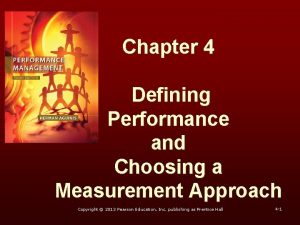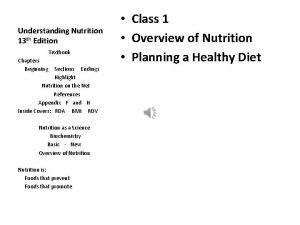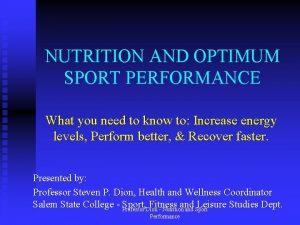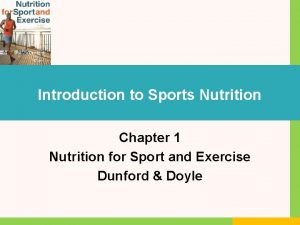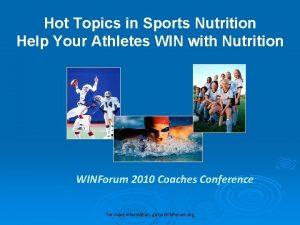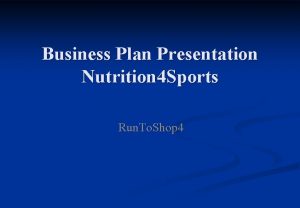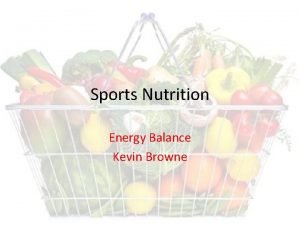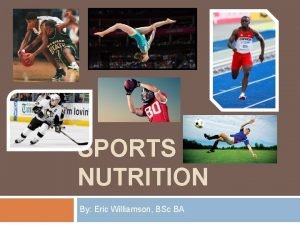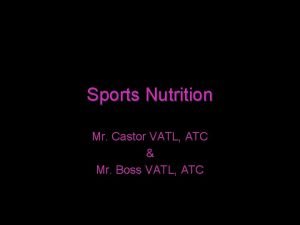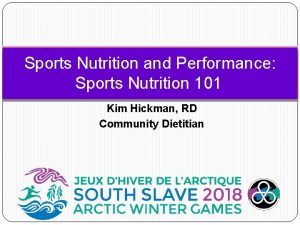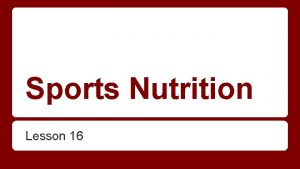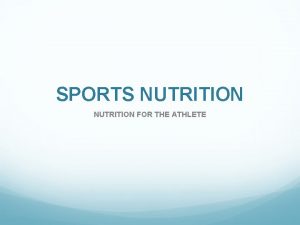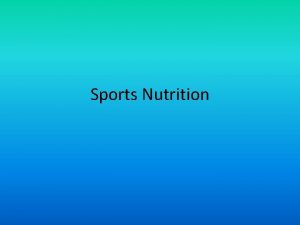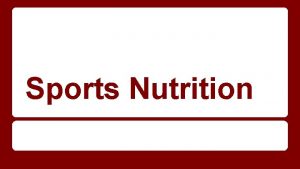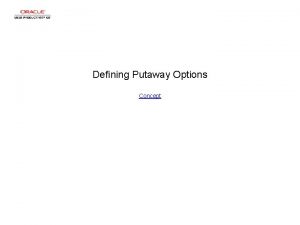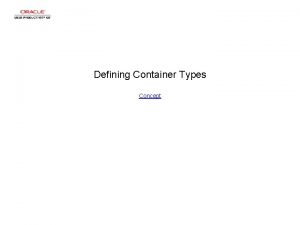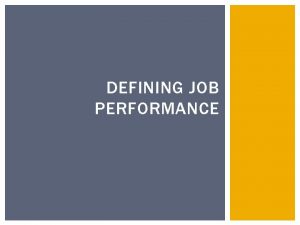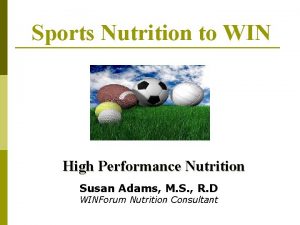SPORTS NUTRITION LAYMAN UNDERSTANDING DEFINING SPORTS PERFORMANCE NUTRITION


















- Slides: 18

SPORTS NUTRITION LAYMAN UNDERSTANDING?

DEFINING SPORTS PERFORMANCE NUTRITION Athletes Have Special Needs! üRequire More Nutrients üIncrease in Protein üIncrease in Carbohydrates üIncrease in Vitamins and Minerals

BENEFITS OF PROPER NUTRITION • Decreased time of recovery • Increased energy • Decreased loss of muscle tissue in-season • Increased stamina • Decreased percent body fat • Injury prevention • Improved health • IMPROVED PERFORMANCE!!

SPORT-SPECIFIC NUTRITION Explosive Athletes üExplosive strength and power is required on a sustained, repetitive basis. üMuscle glycogen is immediate energy source. üHigh protein requirements üConstant supply of carbohydrates to refuel bodies glycogen stores. • Total Caloric Ratio Need ü 20% Fat ü 25% Protein ü 55% Carbohydrate

SPORT-SPECIFIC NUTRITION Endurance Athletes üAerobic pathway is primary energy source. üFatty acids & Muscle glycogen main fuels. üModerate protein requirements üConstant supply of carbohydrates to refuel bodies glycogen stores. • Total Caloric Ratio Need ü 20% Fat ü 20% Protein ü 60% Carbohydrate

RECOMMENDATIONS

CARBOHYDRATES • Limited storage capacity, must replenish • Consume 30 -60 gms/hr continuous exercise • 20 hours to fully replenish • . 05 gms of CHO/lb body wt every 2 hrs • 150 lbs=75 gms every 2 hrs

CARBOHYDRATES RICH FOODS • • ½ cup rice ½ cup spaghetti 4 oz orange juice 1 slice wheat bread ½ cup oatmeal 1 cup corn flakes 1 large banana 25 gms 17 gms 13 gms 11 gms 27 gms 24 gms 31 gms

SIMPLE VS. COMPLEX CHO Complex Carbohydrates üAre absorbed by the body slowly. üDigest & release glucose into bloodstream at slow & steady rate. Slow release of CHO into the bloodstream: üRegulates appetite. üProvides prolonged supply of CHO to the blood stream. üProvides a nutritional energy substrate which will further spare & replenish muscle & liver glycogen.

TYPES OF COMPLEX CARBOHYDRATES üRaw fibrous vegetables like broccoli, spinach, carrots, green beans, cucumbers, tomatoes. üGrains like oats, breads, bran cereals, pasta, rice. üStarchy vegetables like potatoes, corn, peas, beans

PROTEIN • Proteins are the building block of muscle. • Proteins spare muscle breakdown during exercise. • Protein is essential for maintenance, growth & recovery. • . 05 -. 07 gms/lb body wt • 150 lb = 75 -105 gms/day

LOW FAT, PROTEIN RICH FOODS • 85 -95% Lean ground beef, turkey, ham • Beans & peas • Skinless, grilled, baked, roasted chicken or turkey breast • Seafood-steamed, boiled, baked or grilled • Low-fat cottage cheese • • Cheese-2% or skim Milk-Skim or 2% White-tuna in water Trimmed steaks, lamb, pork chop Nuts or seeds Eggs or egg beaters Low-fat yogurt Turkey bacon or sausage

FATS • Higher percentage utilized for energy during low intensity exercise • Essential Fatty Acids required for growth, recovery & overall health • Protective padding for organs • Omega-3 fatty acidsincrease stamina & been saturated fats more efficiently • Sources: walnuts, cold water fish (salmon, trout, herring), crab, canola oil

HYDRATION • • • 2% drop in body water decreases performance Check color of urine; thirst poor indicator 250 ml, 2 hrs prior: 125 to 250 ml every 15 minutes during 500 ml for every 1 kg lost during exercise Sports drinks for electrolytes Foods high in water content

WATER & ATHLETIC PERFORMANCE • Water replenishment is the most important factor during exercise. • Outside the narrow range of 98 -100°F, your body will always sacrifice muscle function for temperature regulation. • Drink a minimum of 3. 5 to 5 litres/day. üFlushes out metabolic waste products üMaintains the bodies cooling system üPrevents muscle cramps, strains and pulls

ERGOGENIC AIDS & NUTRITIONAL SUPPLEMENTATION • Supplements are just that…Supplemental!! • Whole foods should supply basic total caloric intake of an athlete’s diet. • Choose supplements that are high quality, professional grade. Research! • There is no magic pill formula to success!! NO MAGIC!!

THE PRE-WORKOUT RULE • 1 hour prior to activity • Consume a snack meal that is high in complex carbohydrates • Avoid consuming fats and proteins • 500 ml water or sports drink

THE POST WORKOUT RULE • Window of Opportunity: One hour after workout. ü 50 grams of Protein, 100 grams of CHO as post-workout rule. üKey is to replenish muscle glycogen!! ü 500 ml water or sports drink for every kg lost
 Lloyd layman size up model
Lloyd layman size up model Defining relative clauses examples
Defining relative clauses examples Relative clauses defining and non defining
Relative clauses defining and non defining Diferencia entre defining y non defining
Diferencia entre defining y non defining Defining relative clause meaning in telugu
Defining relative clause meaning in telugu Relative clause
Relative clause Non defining relatives clauses
Non defining relatives clauses 3 approaches to measuring performance
3 approaches to measuring performance Approaches to measuring performance
Approaches to measuring performance Understanding nutrition 13th edition rental
Understanding nutrition 13th edition rental Optimum sports performance
Optimum sports performance Introduction to sports nutrition
Introduction to sports nutrition Hot topics in sports nutrition
Hot topics in sports nutrition Sports nutrition business plan
Sports nutrition business plan Bmr sports nutrition
Bmr sports nutrition Eric sports nutrition
Eric sports nutrition Boss sport nutrition
Boss sport nutrition High performance nutrition
High performance nutrition In these activities
In these activities








